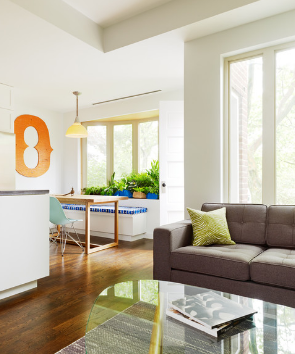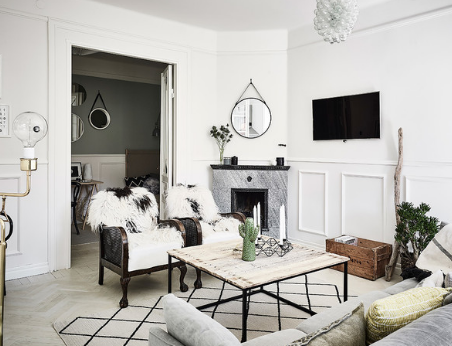

If you don’t have enough space for a 10-foot couch or a giant media console, you’re not alone. Those of us who live in apartments or urban communities often find that space is invaluable.
If this describes your experience, you can choose to treat limited living space as a creative design challenge. The key to living happily and beautifully in a small home is to combine space-saving and versatile solutions that express your personal style at the same time. A wise decision will give you the space you need while making your room extraordinary and welcoming. These 10 tips can help you get the most out of the most important room: the living room.

If you have limited living space, you may want to think of the living room as a fluid space and open doorways or walls where possible to bring adjacent rooms together. If the walls separating the living, dining and kitchen are removed, the living room can become a larger combination of living, dining and kitchen spaces. Similarly, widening the doorway and opening it towards the ceiling creates a larger, more open feeling. If major structural changes are not possible, try simply removing the doors of each connecting space. Not only does this improve sight and light in each room, but it also makes for smoother movements.

It’s a good idea to invest in a built-in solution and the right shelves to meet your space and needs. Custom built-in furniture is ideal for small rooms, as you can adjust the size of each piece of furniture to fit the challenging space while adding a feature or two to maximize its usefulness.
For example, useful storage space can be hidden under the built-in sofa. If hiring a carpenter or buying custom pieces isn’t in your budget, get creative and don your DIY hat. Can you put an attractive folding drawer under the sofa and how about floating a deep shelf with a stand on the wall as a table?
Again, instead of using a custom-made wall unit, place shelves on the wall in a clever pattern to create a media unit. When hanging shelves, place them all the way on the wall to create a vertical pattern. The higher placement of design elements helps to create a sense of volume in the room.

If possible, try to arrange furniture to create a separation between functional areas. This helps to define different uses within a single room. For example, place a table behind a sofa to create a workspace, or arrange chairs and sofas in such a way that the living room is clearly separated from the dining room.
You can further define the layout by placing different overhead fixtures in each individual space. For example, in the living space area, choose a light fixture (flush or semi-flush installation) close to the ceiling. Then, in the adjacent dining space, place a pendant directly above the table.

Emphasize natural light sources to brighten up the room. Sunlit rooms feel more open, helping to eliminate shadows that make enclosed areas feel smaller. The easiest way to enhance the natural light in a room is to place a mirror where you can reflect light from the window. Not only does this reflect light, but it also creates the illusion of more depth in the space. If possible, place the furniture you use most often, such as a sofa or your favorite comfortable chair, in a location where you can see the outdoors.
If there is little natural light, consider installing track lighting. While it doesn’t take up valuable table or floor space, its bright light and flexible track head can be an alternative to direct sunlight.

The classic trick of using white or light tones is still an accurate suggestion for painting smaller spaces. In addition, painting the décor and walls of the room in the same color can catch the eye and accentuate the ceiling, just like this room.
But you can also use darker colors. For example, soothing tones like navy or charcoal gray can make a smaller space stylish and inviting. The trick to a small room is to balance dark walls with light-colored elements to create depth and illuminate the room. For example, place a light-colored sofa against a dark wall. Pair it with more light-colored furniture, shiny accessories, and light-colored rugs.

This may be fairly obvious, but it’s important: avoid furniture that is too large and feels heavy. It will take over and make the room feel smaller. Instead, opt for low-key, streamlined furniture, especially sofas.
Low furniture essentially means low to the ground. For example, a low sofa means that there is a small distance from the floor to the sofa seat. From a design point of view, this often means smaller sofa legs, streamlined cushions, or narrow bases.
Balance the space with the low-to-high wall décor with the extra wall space provided by the low-profile sofa. A good example is hanging a large piece of art or arranging a row of vertical shelves to catch the eye.

When your life is small, you have to ask yourself: can this serve more than one purpose? By letting the key components play a double role, you can easily meet all the needs of the living room. Perfect examples are sideways tables or wall cabinets as desks, as well as very useful pull-out sofa beds.
Storage is another useful feature that can be added to any place that can be accommodated. Try using a bench with hidden storage instead of a dining chair. Instead of floating shelves, opt for floating drawers. They serve the same purpose and provide you with extra compartments to store your essentials. Similarly, place a tray on top of the storage footstool as a multifunctional coffee table.

It may seem counterintuitive, but if possible, use carpets that extend beyond the furniture in each functional space. For example, in the living area, a carpet under a sofa, coffee table, and extra seating will draw the eye and make the living space appear larger. On the other hand, a rug that is slightly larger in size than a coffee table feels more like a bathroom mat, resulting in a limited size for the living space.

Take advantage of the small size of your living room to easily create design features. Specifically, choose an aspect of the room to highlight something visually interesting. The eye will be immediately drawn to this prominent feature rather than emphasizing the challenging size of the room.
A good example is to design a feature wall behind a sofa with colors, textures, or wall décor. Use wall coverings such as straw cloth, place murals on brightly colored walls or place different framed artwork and mirrors.

Although your life is small, that doesn’t mean you can’t include fashion features that represent you. In small rooms, it is easy for furniture to occupy the personality of the room.
Since the living room is where we spend a lot of time, infuse your room with accessories that tell the story of you and your family. Photos of creative photo frames, sentimental gadgets left by grandparents, or personal art or collectibles are all one-of-a-kind decorative elements that can personalize the comfort of your living room.